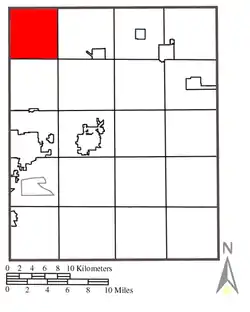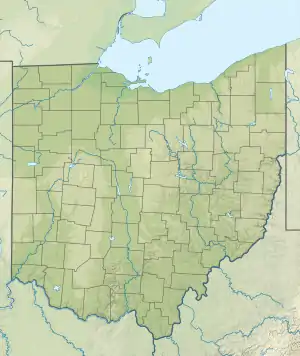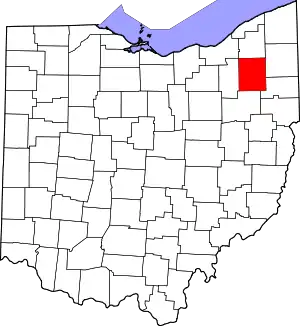Aurora, Ohio
Aurora is a city in Portage County, Ohio, United States. It is a suburb of Akron, Ohio, and is co-extant with, and formed from, the former township of Aurora, which was formed from the Connecticut Western Reserve. The population was 15,548 at the 2010 census.
Aurora, Ohio | |
|---|---|
 Aurora's city hall | |
 Location within Portage County | |
 Location in the United States and Ohio  Aurora, Ohio (Ohio) | |
| Coordinates: 41°19′9″N 81°21′21″W | |
| Country | United States |
| State | Ohio |
| County | Portage |
| Government | |
| • Mayor | Ann Womer Benjamin |
| Area | |
| • Total | 24.06 sq mi (62.31 km2) |
| • Land | 22.91 sq mi (59.34 km2) |
| • Water | 1.15 sq mi (2.97 km2) |
| Elevation | 1,132 ft (345 m) |
| Population | |
| • Total | 15,548 |
| • Estimate (2019)[3] | 16,338 |
| • Density | 713.04/sq mi (275.31/km2) |
| Time zone | UTC-5 (EST) |
| • Summer (DST) | UTC-4 (EDT) |
| ZIP code | 44202 |
| Area code(s) | 330 |
| FIPS code | 39-03086[4] |
| GNIS feature ID | 1064359[5] |
| Website | www.auroraoh.com |
Aurora was designated a Tree City USA by the National Arbor Day Foundation.
Some say Aurora was the name of the daughter of Major Amos Spafford, while others believe the village was named after Aurora, the Roman goddess of dawn.[6]
Geography
Aurora is located at 41°19′9″N 81°21′21″W (41.319254, -81.355859).[7] It borders or touches the following other townships and municipalities:
- The city of Hudson, on the southwest (touches, but does not border)
- The city of Solon, on the northwest (touches, but does not border)
- Bainbridge Township, Geauga County, on the north
- Auburn Township, Geauga County, on the northeast (touches, but does not border)
- The City of Streetsboro, Portage County, on the South
- The City of Twinsburg, Summit County, on the West
According to the United States Census Bureau, the city has a total area of 24.07 square miles (62.34 km2), of which 22.92 square miles (59.36 km2) is land and 1.15 square miles (2.98 km2) is water.[8]
Demographics
| Historical population | |||
|---|---|---|---|
| Census | Pop. | %± | |
| 1880 | 222 | — | |
| 1940 | 518 | — | |
| 1950 | 571 | 10.2% | |
| 1960 | 4,049 | 609.1% | |
| 1970 | 6,549 | 61.7% | |
| 1980 | 8,177 | 24.9% | |
| 1990 | 9,192 | 12.4% | |
| 2000 | 13,556 | 47.5% | |
| 2010 | 15,548 | 14.7% | |
| 2019 (est.) | 16,338 | [3] | 5.1% |
| Sources:[9][10][4] | |||
2010 census
As of the census[2] of 2010, there were 15,548 people, 6,018 households, and 4,365 families residing in the city. The population density was 678.4 inhabitants per square mile (261.9/km2). There were 6,396 housing units at an average density of 279.1 per square mile (107.8/km2). The racial makeup of the city was 93.9% White, 1.0% African American, 0.1% Native American, 3.9% Asian, 0.2% from other races, and 1.0% from two or more races. Hispanic or Latino of any race were 1.3% of the population.
There were 6,018 households, of which 32.9% had children under the age of 18 living with them, 62.5% were married couples living together, 7.1% had a female householder with no husband present, 2.9% had a male householder with no wife present, and 27.5% were non-families. 24.0% of all households were made up of individuals, and 12.1% had someone living alone who was 65 years of age or older. The average household size was 2.54 and the average family size was 3.03.
The median age in the city was 45.4 years. 24.6% of residents were under the age of 18; 5.3% were between the ages of 18 and 24; 19.7% were from 25 to 44; 31.6% were from 45 to 64; and 19.1% were 65 years of age or older. The gender makeup of the city was 47.9% male and 52.1% female.
2000 census
As of the census[4] of 2000, there were 13,556 people, 5,047 households, and 3,901 families residing in the city. The population density was 583.8 people per square mile (225.4/km2). There were 5,361 housing units at an average density of 230.9 per square mile (89.1/km2). The racial makeup of the city was 95.67% White, 1.16% African American, 0.10% Native American, 2.24% Asian, 0.01% Pacific Islander, 0.13% from other races, and 0.69% from two or more races. Hispanic or Latino of any race were 0.58% of the population.
There were 5,047 households, out of which 35.2% had children under the age of 18 living with them, 68.9% were married couples living together, 6.5% had a female householder with no husband present, and 22.7% were non-families. 19.0% of all households were made up of individuals, and 7.6% had someone living alone who was 65 years of age or older. The average household size was 2.63 and the average family size was 3.02.
In the city the population was spread out, with 25.7% under the age of 18, 4.6% from 18 to 24, 27.3% from 25 to 44, 26.9% from 45 to 64, and 15.5% who were 65 years of age or older. The median age was 41 years. For every 100 females, there were 92.9 males. For every 100 females age 18 and over, there were 88.9 males.
The median income for a household in the city was $112,547, and the median income for a family was $128,432. Males had a median income of $100,797 versus $53,846 for females. The per capita income for the city was $69,672.
Education
Aurora City School District operates three elementary schools (Leighton, Craddock, and Miller), one middle school (Harmon), and one high school, Aurora High School.[11] In 2019, Aurora High School was ranked second in Northeast Ohio, ninth in the state, and 308th in the nation. 78% of its students participate in Advanced Placement®. Furthermore, it boasts a 18:1 student-teacher ratio, with 986 students.[12]
Aurora is home to Valley Christian Academy,[13] and is a nearby community for other private schools.
Aurora has a public library, a branch of the Portage County District Library.[14]
Culture, recreation, and sports

Parts of central Aurora have been designated the Aurora Center Historic District. The historic district was listed on the National Register of Historic Places in 1974.[15]
The city has several private country clubs, including Club Walden and Barrington Golf Club. In addition, it was home to the historic Aurora Golf and Country Club. In 1924, Bert Way designed the championship golf course. The course wound through 220 acres of spectacularly crafted landscape, with the Chagrin River flowing through a majority of the holes. It was constructed in natural rolling terrain, with the Aurora branch of the Chagrin River being a significant feature. In 1967, 1969, and 1970, the club hosted the Cleveland Open. Arnold Palmer once battled the course while competing in this PGA event; Arnold Palmer, along with Bruce Devlin, Charlie Coody, Gary Trivisonno, and Tom Laubacher, held the course record of 64. After 88 years, in 2012, Aurora Golf and Country Club shuttered its doors. The former course has now been converted into the Paddock River Preserve.[16]
Various recreational facilities operated on the site of Giles Pond, also known as Geauga Lake, continuously since before 1887.[17] The Big Dipper roller coaster operated for 82 years at the site.[18]
Aurora historically was the second location for the SeaWorld chain of marine mammal parks, which opened in 1970 and operated in the Geauga lake area on the northern edge of the city and was home to the killer whale (Orca) known as Shamu.
Aurora High School, in 2008, were the Division III State Champions in football.
In 2016, Aurora Robotics Team TBD won the FIRST Tech Challenge world championship in St. Louis, MO.
Notable people
- Blanton Collier - Professional football coach in the National Football League (NFL) for the Cleveland Browns
- Gary Collins - Professional football player in the NFL
- Tom Curtis - Professional football player in the NFL
- Jericka Duncan - American TV news correspondent
- Sean Grandillo - Actor
- Anne Heche - Actress
- Fritz Heisler - Professional football coach, assistant coach, and scout in the NFL for the Cleveland Browns
- Chris McCarrell - Actor
- Bernie Parrish - Professional football player in the NFL
- Dick Schafrath - Professional football player in the NFL
- Jim Thome - Professional baseball player in Major League Baseball, lived in Aurora while playing for the Cleveland Indians
References
- "2019 U.S. Gazetteer Files". United States Census Bureau. Retrieved July 27, 2020.
- "U.S. Census website". United States Census Bureau. Retrieved 2013-01-06.
- "Population and Housing Unit Estimates". Retrieved May 21, 2020.
- "U.S. Census website". United States Census Bureau. Retrieved 2008-01-31.
- "US Board on Geographic Names". United States Geological Survey. 2007-10-25. Retrieved 2008-01-31.
- Overman, William Daniel (1958). Ohio Town Names. Akron, OH: Atlantic Press. p. 7.
- "US Gazetteer files: 2010, 2000, and 1990". United States Census Bureau. 2011-02-12. Retrieved 2011-04-23.
- "US Gazetteer files 2010". United States Census Bureau. Archived from the original on 2012-01-25. Retrieved 2013-01-06.
- "Number of Inhabitants: Ohio" (PDF). 18th Census of the United States. U.S. Census Bureau. 1960. Retrieved 24 April 2020.
- "Ohio: Population and Housing Unit Counts" (PDF). U.S. Census Bureau. Retrieved 22 November 2013.
- "About the district". Aurora City Schools. Retrieved 3 March 2018.
- https://www.usnews.com/education/best-high-schools/ohio/districts/aurora-city/aurora-high-school-15676
- https://www.valleychristian.com/
- "Hours & Locations". Portage County District Library. Retrieved 3 March 2018.
- "National Register Information System". National Register of Historic Places. National Park Service. March 13, 2009.
- https://www.auroraoh.com/708/Former-Aurora-Golf-Course
- "Six Flags History". Aurora Chamber of Commerce. Archived from the original on 16 February 2008. Retrieved 23 February 2008.
- "Geauga Lake is no more". Theme Park Insider. Archived from the original on 14 February 2008. Retrieved 2008-02-23.
External links
| Wikimedia Commons has media related to Aurora, Ohio. |
